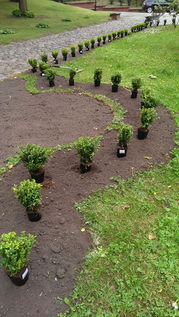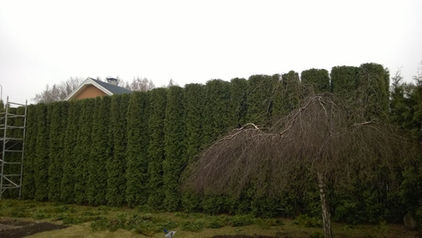
Hedge planting and maintenance
A beautiful hedge is like a garden ornament with a very functional value. Its shaping is a long-term issue that requires time and knowledge. But the work invested will definitely be worth it! Stādam.lv offers planting and maintenance of various types of hedges.
When is the best time to install the hedge? Now! As hedge planting requires preparatory work:
What is the purpose of the hedge?
The most common is the protective barrier against the influence of strong wind in more open areas, creating a private space from the neighbours, reducing the noise of the surrounding infrastructure, symbolic separation of the garden area and a decorative element instead of the fence.
The most suitable time
Hedge planting shall be performed in the spring, but it is also possible during the season while the ground is not frozen. When planning larger garden works, we recommend installing the hedge before lawn laying and landscaping the garden not to damage the already installed lawn and plants.
Budget
Prices are determined individually according to the scope of work and the necessary material costs. Someone needs a full cycle of work, both site clearance and soil replacement, while someone else only supply and installation of the planting material. The estimate is executed and agreed before the work initiation. Use our form to find out the hedge planting cost.
You don't have to become a gardener to enjoy a beautiful garden Stādam.lv team will help you make the best decisions in the installation process, as well as familiarize you with the necessary maintenance work.
Hedge types
We will help you choose the most appropriate type of hedge according to the desired visual result, the functional task of the hedge, the space allocated for it and the composition of the rest of the garden.
-
Conifer hedge, for which various species of thuja, fir, yew, juniper, cypresses are usually chosen. Evergreen hedges are decorative in all seasons, they form an impenetrable wall even during the period when deciduous shrubs are leafless. Such hedge will usually be more voluminous, higher, especially suitable for building perimeters of the territories, as it protects from both wind and prying eyes.
-
The hedge of deciduous shrubs such as barberry, spirea, dogwood, jasmine. They usually have brighter foliage accents. Green foliage consists of privets, alpine currant, spireas. Such hedge will be gorgeous, more compact, but in the winter season it will be transparent.

Hedge planting
You should pay attention to some conditions if you want the hedge to fully fulfill its functions and thrill you with its beauty every day for many years:
-
Proper soil preparation. It should be prepared according to the requirements of each species. The infertile soil should be completely replaced with fertile soil, adding organic fertilizer to it. Depending on the planting distance, which can be from 70 cm for conifers and from 50 cm for deciduous shrubs, it is changed for each plant individually or in a trench. A trench is usually dug 60 x 60 cm deep and wide for conifers, for deciduous shrubs - 40 x 40 cm.
-
Selection of plants. Only high-quality plants will be able to take root, grow, green and form a homogeneous hedge. Stādam.lv team chooses plants only from reliable, years-tested cooperation partners to always ensure excellent quality.
Hedge maintenance
You should properly take care of the hedge if you want it to be a decoration of your garden for a long time. A qualitatively installed and properly maintained hedge will thrill you for many years.
-
Watering You should ensure regular watering throughout the season until autumn.
-
Fertilization. Hedge plantings should be fertilized in the spring. It is a long-acting fertilizer that dissolves as a result of watering and precipitation, providing the necessary amount of minerals throughout the season.
-
Forming 1-3 times a year, depending on the selected plant species. Deciduous shrub hedges can be cut both in spring (except for those that are very juicy in spring, such as common hornbeam or common beech, as they can suffer greatly from spring cutting) and in autumn. Proper and timely trimming of hedges ensures not only visual appeal, but also plant health.
The most popular hedge plants

Western thuja Brabant
forms a green, opaque wall. You should shape both the side and the top to limit the growth.

Western thuja Smaragd
has a pyramidal shape, stands out with a bright colour of needles.

Physiocarpuses, cornuses
are used in both free-growing and formable hedges. Durable, fast-growing, with various bright colour variations.

Common Hornbeam
forms a dense, green wall, can be shaped, leaves remain for a long time in autumn.


















